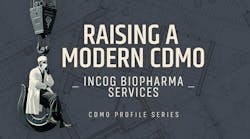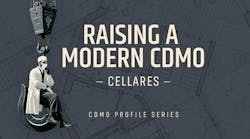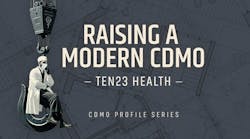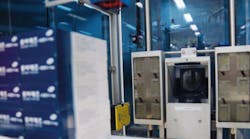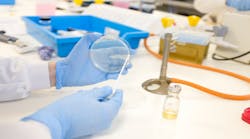For many companies starting out, the financial risks of building a traditional facility, and the requirements for designing, optimizing and controlling a GMP manufacturing process, are too daunting. A growing number of companies with drugs in early-stage development are working with Xcellerex, a contract manufacturing company and drug developer whose entire platform is based on the FlexFactory Biomanufacturing Platform (FF), which uses disposable process equipment and enclosed, adjustable cleanrooms around equipment. The company also provides engineering, analytical, process control, IT and other expertise in an outsourced package.
At a time when many contract manufacturing organizations lag in their use of novel technology, Xcellerex is clearly marching to the beat of a different drummer. Founder and CTO Parrish Galliher discussed recent developments.
PhM: How has your base grown since you’ve launched, and how many people work on FF as opposed to other businesses?
PG.: We developed FlexFactory back in 2001, and used it internally when the company was launched two years later. We only started marketing it this year. We figured it would take time to gain support for the concept, since pharma is such as conservative industry.
We started the adoption by using the FF internally to provide contract manufacturing services, thus showing customers how it works, as they put drugs in the clinic that were made in the FF, over time the technology would be validated.
Another benefit is that we have been able to debug and “harden” the system. In 2003 we were only at 100-liter scale. In parallel to setting up and running the FF and making drugs in it, we scaled up to 1000-liter working volume, to show that one could use the FF to make enough product to carry a drug all the way to market and make enough for the market itself.
PhM: How many people are working on the FlexFactory portion of the business?
P.G.: We’re 105-110 right now, and will be growing to about 120 people . . . about 50 are dedicated to the contract manufacturing services part of the company, which provides contract services for companies and works on our own drug pipeline. We’re filing our own first IND this quarter. This contract manufacturing services team will be growing to 70 people over the next few months. The rest of the organization manages the engineering for building bioreactors, mixers and FF’s and servicing them. We have about 100 systems out in the world.
PhM: Are you focusing on specific therapeutic categories?
P.G.: We decided to be opportunistic and look selfishly at the drug class that would best demonstrate the benefits of the FF. Two years ago we decided it should be a vaccine. We had no idea at that time that there would be such a revolution occurring in the vaccine industry. We just got lucky.
PhM: Are you just focusing on the front end, in getting processes up the ground? What happens when companies need to move beyond the disposable equipment stage?
P.G.: If you do the math, the 2000-L flex factory is big enough to supply most countries, and we’re working on a 5000-L scale. We don’t see any practical limit to the scale to which we can take the technology.
In parallel, titers are being raised all the time. We have a high throughput screening process optimization team onsite, whose job it is to raise titer up so high that you never have to go beyond the scale at which we’re doing single use manufacturing. We have completed 10 contracts and have three others running right now in which we are raising titers for both companies.
In May, we published results showing how we raised the titer eight-fold for one client, shrinking a 10,000-L stainless steel down to a 1,200-L single-use plant. Suddenly you don’t have to build a $500 million plant but can build a $25 million plant . . . and can have it validated and running within one year vs. 3-6 years.
PhM: Do you collaborate/work with E&C firms?
PG: In 2003 I began visiting all major E&C firms that I used to work with. Back then they didn’t believe that FlexFactory would ever be real. Six years later they are coming to us, we have a teaming agreement with one of the very large companies, and two others that want to go into teaming agreements with us. These are the early adopters. They’re seeing the writing on the wall. The age of stainless steel, traditional, hard piped plants is over, and there’s a move to very flexible, modularized singled use plants and they’d better get on the bandwagon or they’ll be left in the rear view mirror. It has been fun to have them come around full circle. We are already working with them in the U.S. and Europe. They’ll build the building, labs and utilities infrastructure, and Xcellerex will provide the modular production line that will wheel into the building.
PhM: When a client signs up for FlexFactory, what happens next?
PG: Let me talk about Crucell. We build a FF line for them here at Xcellerex. We do all the FAT on it. In parallel, Crucell is auditing our quality systems, and we’re making sure that all the i’s and t’s are ok with them. Once Flex factory is tested by engineering, we will do GMP manufacturing of Crucell’s product here before the FF is transported to Crucell’s facilities. That gives them a 4-6 month jump on clinical trials, which is substantial in this business.
While we produce GMP products for the clinic, they send their manufacturing team here on the floor to be trained on the flex factory. By making their own drug here on their own new FlexFactory, they’ll hit the ground running when the facility arrives. Their clinical group, meanwhile, has picked up a few months by sourcing the clinical material and contracting with us.
They signed the contract in late June and their FlexFactory will arrive in Europe in late Feb-March, so the timeframe is about nine months.
In parallel, we provide to Crucell’s engineering company, a design specification for the facility in which the FlexFactory will sit, detailing utility connections and HVAC requirements we worked out with FDA.
PhM: Do you handle all validation in house? How do you prevent disconnects at client sites?
PG: There’s a huge value in a pre-running factory with the people who will own it. This reduces risk of misfire at customer site. When we transplant the FlexFactory to the customer’s site, we go with it to the site, to complete the installation and the re-firing of the line. Next, we have fully automated FlexFactory so that we can diagnose any module, instantaneously, and in real-time over the web.
We have a mission control center here now where we can watch any plant make anything….we’d tie into our monitors and be able to diagnose and troubleshoot online. If we can’t manage electronically, our European service group will make the visit.
PhM: What automation platforms do you use?
PG: We’ve looked at a number of them over the years. We wanted an open system, so we learned some ropes. We brought those systems in-house and have tried them out. We use a Wonderware In-Touch system with very open architecture that can talk to other systems out there. It’s also easily integrated into the existing facility SCADA system. We can also provide an EBR that’s based on the Wonderware In-Touch technology. We use Rockwell and Allen Bradley systems, but we can also work with Delta V.
PhM: You seem to be taking different approach to Crucell than to Novavax?
PG: Novavax has a very small manufacturing capacity in Rockville, suitable for clinical. Our contract with them is to produce significant quantity of doses for Mexico and they already have our bioreactors at Rockville. In terms of long term supply, it’s a little bit uncertain how it will work out. Novavax is actively licensing their technology around the world.
PhM: Novavax is locking down everything to the raw material source. Did you help advise them on this course of action and do you recommend this approach to companies at their state of development?
PG: We feel that this is one of our key differentiators. We don’t just throw systems over the wall and say “see you later.” We are a process technology company and have teams of process engineers, biologists, biochemical engineers, protein chemists, analytical chemists and biochemists, all of whom have come from drug companies. We can provide a lot of process input to anyone who comes in the door and help them make their process successful. It’s a pretty complicated space, when you scale up there are so many variables, and most companies need a lot of assistance. The virtual ones need a lot of assistance, larger companies need less but then there’s everyone else in between. We don’t sell tanks, but entire capabilities.
PhM: How do you customize the FlexFactory, including isolators? Do you use a standard model?
PG: The FF modules are not isolators, which are very restrictive. The word isolator is used in sterile manufacturing and aseptic filling. We’re just doing bulk manufacturing. Modules don’t have to be sterile and we’ve literally collapsed the standard clean room. It runs just as clean, but it only needs to be sanitized, not sterilized, so it gives operators more freedom to modify and adjust the module from one batch to another. It offers a high level of flexibility.
We look carefully at ergonomics and we place openings all around the module in a variety of positions to make sure there’s no more than a 12-15 inch reach from outside to the equipment inside. We’re now in our third generation of modules and we’ve made them flexible themselves. Their size can be adjusted simply by inserting spacers in the module walls. Thus, we can change the volume of a module so that you can enlarge it to place a bigger machine inside for the next batch.
For traditional ports, ergonomics is not an issue since we got rid of the fixed gloves. FDA doesn’t like fixed gloves and neither do operators.
We use oval gloves and iris ports and have shown they are perfectly acceptable from a monitoring standpoint. Over the years, we’ve addressed the isolator stigma and brought it to a whole new level of agility. Now you can open up the whole plant instead of having three cleanrooms, operators can be free to move around the whole plant.
In traditional facilities, if an operator wanted to go from one end of the manufacturing line to the other, he or she would have to re-gown twice. In Flex Factory, operators can walk down the line in 30 seconds, in the same gowning, and simply change out their disposable gloves. Overall, we take a holistic view of ergonomics, and we have a great degree of freedom with these modular systems.
PhM: Are you fitting PAT type systems into FlexFactory units?
PG: Some level of PAT is already embedded into the automation. Nonviable online particulate monitors are on the equipment and used to ensure proper air quality during the manufacturing itself. We do open modules to change out disposables. When we close them back up we use particulate monitors to tell us that each module is again at the proper air quality.
The next level of PAT is to have online quality assurance in the form of a compliance watchdog. When an operator does an operation process step, they are following an SOP or a number of SOP’s. There is no real way to prove that they followed, or didn’t follow, the SOP unless someone is standing next to them and verifying. That would double labor costs. We can now do that witnessing electronically, so we’ve written what we call a compliance watchdog capability that verifies electronically that the operator is following the SOP. It’s not technically PAT but the spirit is there, in a real-time monitoring of operator activities and compliance with GMPs and SOP. PAT experts at FDA loved that.
A third level of PAT would be to have sensors in the process stream to detect product quality. Nobody has that in the industry at this point and that’s the Holy Grail. We’d love to get there but so far, nobody’s there yet.
